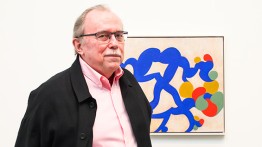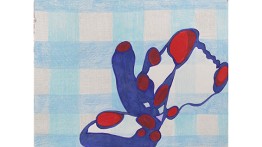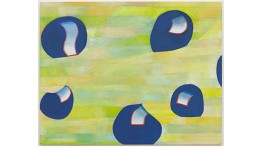Thomas Nozkowski A'67, Lauded Painter, 1944-2019
Error message
Warning: Undefined array key "#items" in cooper_preprocess_node() (line 418 of themes/custom/cooper/cooper.theme).POSTED ON: May 16, 2019
Thomas Nozkowski A’67, a lauded artist of abstract paintings who stayed connected to his alma mater throughout his life, has passed away. He last appeared at The Cooper Union in 2018 as part of a panel of critics and painters, including Lois Dodd A'48 and Philip Taaffe A'77, discussing the notion of Rewriting Painting. During the discussion he characterized his relationship to his craft: “My problem with painting…is that a I really like doing it. I could sit around all day and just push paint around and not get bored. What I have to do, sometimes, is try and clarify what it is that I’m doing. I’m here. This much has happened. Where is it pointing me? What do I have to do to make it completed?”
“A gentle giant,” is how Adriana Farmiga A’96, associate dean and adjunct professor at the School of Art, describes Nozkowski. “He was kind, caring, disciplined, unwavering, principled, a lover of color and form, a pillar in the community, a loving dad, and a devoted husband. A real artist. Confident but never arrogant.” Farmiga knew him personally as they were upstate neighbors, with each working from their studio a few miles apart in the Hudson Valley. “He loved the area of the ‘Gunks’ [Shawangunk Ridge] and the beauty it holds, not to mention the rich artistic history it has as the landscape of the Hudson River School. Tom was truly a part of this community.”
After working mostly in sculpture until the mid-1970s he switched to painting, creating the works that would become his hallmark, earning him many group and solo exhibitions, including two in 2018. His last solo show, Thomas Nozkowski: 16 x 20, at Pace gallery, featured the works he became best known for: off-the-shelf 16x20 prefabricated canvases on which he would create abstract works founded in events of his own experience, but whose sources remained obscured by leaving all the works untitled but for a numbering system. A monograph of his work, Thomas Nozkowski, was published in 2017 by Lund Humphries.
In its obituary of Nozkowski, Artforum described his paintings as, “little, lyrical abstractions evok[ing] large and shifting themes—from memory and nature to cosmology.” Artsy.net described him as a “master of color and scale,” and “an influential figure for generations of American painters, not only through his many solo exhibitions—including at his gallery, Pace—but also through his extensive teaching at Rutgers University, where he became a professor in the Mason Gross School of the Arts in 2003.”
But it was through his day job that Nozkowski likely reached his largest audience and perhaps influenced far more impressionable minds, though they did not realize his role in their lives. For decades he worked as the Production Director at Mad magazine, a position he attributed directly to his education at Cooper Union. He recalled his time at the school in an interview along with his wife, Joyce Robins A’66, that appeared on Hyperallergic.com:
“Most of our teachers were second generation Abstract Expressionists, along with a few ex-Bauhaus or ex-Albers students who ran the two-dimensional design, color, and photography parts of the program. I was at Cooper the second year they offered the degree [Bachelor of Fine Arts; prior to that a Certificate was offered. -ed.]. It was still very much a school for working. You would go to school five days a week from 9 AM to 5 PM and it was intense. Everybody took the same courses. … It made us employable, which is always good. I worked in magazine design for years: at Time magazine, and as the production director of Mad magazine. I designed hundreds of books. My specialty was pop trash: UFOs, Movie Tie-Ins, Disco Dancing, Celebrity Biographies and Bermuda Triangle books. I even wrote one of those.”
Asked if she could share an anecdote, Farmiga recalled of Nozkowski, “Originally, the first ‘hello’ I had was to approach Tom and Joyce in 2012 for works for an auction we were planning with Phillips de Pury. But in this initial conversation, they instead invited me over to see their studios, and showed me incredible generosity as humans, as artists, and as alumni. We discussed many things once we established our love and concern for the future of Cooper Union: gardening, swimming, radiant heat systems, the burgeoning local scene upstate, etc. That same summer, just after the clocktower occupation ended at Cooper, Tom and Joyce came to a BBQ weekend we hosted, and met many of the students involved with the protests. His/their love for Cooper was clear.”








